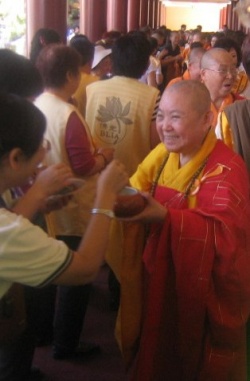Tantrism
A system of yoni-worship, or female-centered sex-worship, which allegedly begun thousands of years ago in India by women of a secret sect called Vratyas, the processors of the devadasis or sacred harlots. The religion was associated with later written scriptures known as Tantras, therefore, it became known as Tantrism.
Its primary objective was the adoration of the lingam-yoni, sign of the male and female principles in conjunction (the god Shiva and the goddess Kali). Tantrism is still practiced in India, Nepal, Bhutan, and Tibet.
The basic tenet of Tantrism was that the woman possesses more spiritual energy than the man; therefore, the man could achieve realization of the divinity through sexual and emotional union with a woman. A fundamental rite was controlled sexual intercourse, maithuna, Latin, coitus reservatus; sex without male orgasm. In theory the man must store up his sexual fluid rather than expelling it by ejaculation.
Through Tantric training, he learned to absorb through his penis the fluid engendered by his partner’s orgasm and to prolong sexual intercourse for many hours. In this way he became similar to Shiva, the God in perpetual union with the Goddess. Theoretically, the concept was that the conserved vital fluids would be stored in the man’s spinal column, working their way up through the chakras to his head, and there flower the inspiration of divine wisdom. The Tantras explains the purposes of the various rites and the philosophy underlying them.
The most sacred mantra expressing Tantric worship was Om mani padme hum, the Jewel (penis) in the Lotus (vulva). The symbolic lingam-yoni often took the form of an altar shaped like a penis in a vulva.
The practice met with opposition as did its Christian counterparts, namely the Ophites and Montanists. Orthodox Buddhism was based on opposition to the female principle and believed in order to saved their souls men must avoid sex. The vitality of the soul was retained by the conservation of semen, and the concentration (see Meditation) on the Self. Buddhist monks claim their prophet commanded them to quell all sexual desire, and to never see or speak to a woman.
Tantrism was never completely destroyed. It has been practiced in different forms or versions throughout the centuries. It was practiced by some early Christians who called it synesaktism, the Way of Shakti, which was a form of Goddess-worship that had come from the Orient through Pythagorean and Neoplatonic mystics. Plotinus equated the mind’s progress toward Ineffable to "the sight of a beautiful lady." The ascent of the mind toward the realization of divinity was divided into six steps, the first being the perception of woman’s beauty to the culmination with the contemplation of Universal Beauty.
However, as with everything which incorporates natural tendencies but also denies them this form of Goddess-worship traveled a bumpy road. One big obstacle was when the Christian Church declared that the sole purpose of sex was for the propagation of children. This lead to the obstacle of others being suspicious of those practicing it, thinking promiscuity was occurring among them.
Some early Christian sects such as the Gnostic Ophites practiced a form of Tantrism by adoring their Goddess symbol of Sophia. She was thought of as the Holy Spirit, the feminine soul or the Shakti of God. They called their rite a spiritual marriage which was completely misconceived by the orthodox Church which condemned it. Certain members of these sects laid naked together while copulating. Their rite was suspicious in that they say they only avoided male orgasm. As previously mentioned promiscuity was suspect.
Christians were not the only ones attacking such practices, the Islamic leaders also were attacking the Sufi cults of love. Sufi mysticism survived underground, carried on by troubadours calling themselves Lovers and adoring the feminine principle as a world-sustaining power.
The Sufi worship eventually influenced the European troubadours, who founded cults of Courtly Love in the centuries following the crusades. Such troubadours were branded sinful by the Church because they loved women instead of God; and, women were equated with the devil by the theological opinion of the time. The patriarchal authority was not going to approve something that was natural as good, such an act would seem to grant the right of sexual pleasure to women.
Although Courtly Love practiced Tantric maithuna under the name of drudaria, a sort of love associated with male self-denial, it was anything but chaste. To the contrary, its poetry was highly erotic. The bardic verse indicated Tantrism origins, especially when Peredur’s mystic lady-love revealed that she came from India or when Tristan told his lady-love Iseult that his name was the syllabically-reversed Tantris.
There are indications that Tantrism was present throughout the history of western nations. It was either taught through secret teaching or discovered independently. Medieval goddess-worshippers, valified as "witches" apparently knew of it. There are indications that it was taught and used as a birth-control technique. Many alleged witches were midwives whom the Church thought were teaching birth control. Also, there is no evidence of women becoming pregnant after returning from witches’ sabbats.
Maithuna was heard of once more, in 1848, when John Humphrey Noyes, founder of the Oneida Creek Community, rediscovered the technique which he called "male continence’ or karezza. Noyes’ initial reason as to protect his wife from "the horrors and the fear of involuntary propagation" after she had four disastrous pregnancies. Afterwards Noyes trained members of his community in the technique and they began experimenting in what was called "complex marriage" where the various partners had no fear of unwanted pregnancies.
Some occult groups in the 19th and 20th centuries used Tantric coitus reservatus for various reasons. However, maithuna was not widely practiced by Western men because of Christian and cultural teachings. A.G.H.
see also: vajrayana


